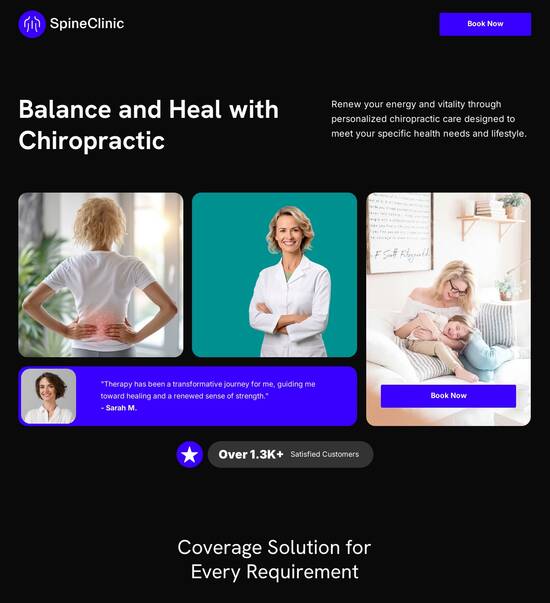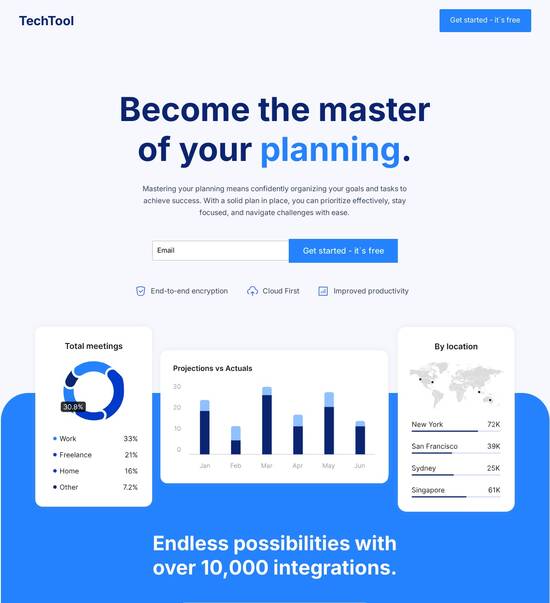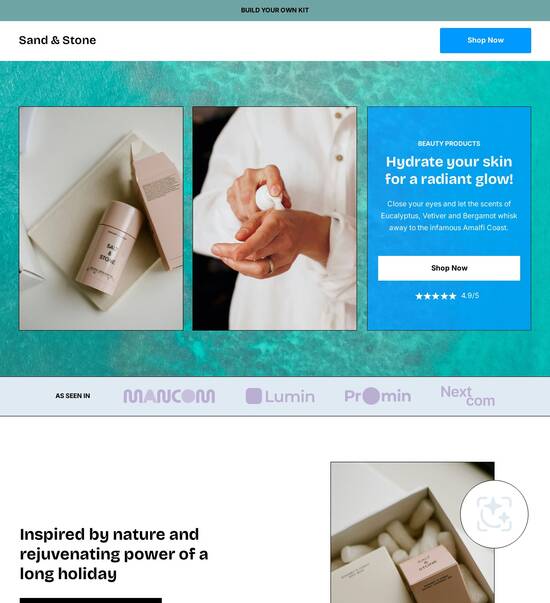
React.js optimized 401 unauthorized page template
Explore Similar TemplatesAbout template
Supercharge your 401 unauthorized page with React.js for outstanding performance! Learn more today.
Recommended templates

Easy to build without coding
With the intuitive drag-and-drop builder, anyone on your team can create high-converting pages without any knowledge of code or design. Make enhancements to your landing page with custom widgets using Javascript, HTML/CSS, or third-party scripts.

Multiple layouts for any industry and goal
Select from 500+ landing page layouts built to boost conversions across industry-specific scenarios. Customize them by adjusting fonts, adding images, and generating on-brand content with the AI assistant. Quickly scale with Instablocks® and Global Blocks that you can save, reuse, and update globally.

Loads fast and looks polished on any device
Every template is responsive, which means they present professionally on any device and load blazingly fast with our Thor Render Engine. You can also power them up with Google AMP technology to deliver an unparalleled mobile experience and drive higher conversions.

Robust analytics & experimentation
Get real-time updates and reporting across all your devices, showing the number of visitors, conversions, cost-per-visitor, and cost-per-lead. Launch AI-powered experiments, run A/B tests, and use heatmaps to analyze user behavior, then optimize your landing page to maximize conversions.







Easy to build without coding
With the intuitive drag-and-drop builder, anyone on your team can create high-converting pages without any knowledge of code or design. Make enhancements to your landing page with custom widgets using Javascript, HTML/CSS, or third-party scripts.
Multiple layouts for any industry and goal
Select from 500+ landing page layouts built to boost conversions across industry-specific scenarios. Customize them by adjusting fonts, adding images, and generating on-brand content with the AI assistant. Quickly scale with Instablocks® and Global Blocks that you can save, reuse, and update globally.
Loads fast and looks polished on any device
Every template is responsive, which means they present professionally on any device and load blazingly fast with our Thor Render Engine.
Robust analytics & experimentation
Get real-time updates and reporting across all your devices, showing the number of visitors, conversions, cost-per-visitor, and cost-per-lead. Launch AI-powered experiments, run A/B tests, and use heatmaps to analyze user behavior, then optimize your landing page to maximize conversions.
All the features you need to build unauthorized page design
Explore more featuresLearn how to build how to fix 401 unauthorized error
Frequently asked questions about template 401 react
Leading the way in building high-performing landing pages





401 unauthorized error how to fix: Your ultimate how-to guide
Instapage is the ultimate solution for marketers looking to enhance their digital strategies through optimized landing pages. In this guide, we delve into the capabilities of Instapage, demonstrating how its intuitive features can maximize the efficiency of your marketing campaigns and significantly increase your ROI.
Why choose Instapage?
Instapage stands out due to its combination of easy usability and robust functionality. With access to over 100 customizable templates, any marketing team can craft highly effective landing pages that resonate with targeted audiences. This approach simplifies the process and empowers teams of any size to launch campaigns swiftly without technical complications.
- User-friendly interface: Instapage requires no coding knowledge, making it accessible for all marketers.
- Pre-designed templates: Save time with templates that have already proven successful in generating leads.
- Flexible customization options: Tailor each page to fit your brand’s voice without the complexity of traditional web design.
Steps to creating high-converting landing pages
Follow these key steps to maximize your page effectiveness with Instapage:
- Select a template: Choose from a library of high-converting pre-built templates tailored for various industries.
- Utilize the drag-and-drop builder: Easily add text, images, and forms to customize your landing pages.
- Implement A/B testing: Optimize the performance of pages by experimenting with different elements and analyzing user behavior through detailed analytics.
Optimize for audience engagement
Next, focus on personalizing the user experience to enhance engagement mechanics:
- Dynamic content insertion: Use dynamic text replacement to tailor messages to each specific segment of your audience.
- Audience targeting with AdMaps: Connect your ads directly to optimized landing pages for a seamless user experience.
- Measure effectiveness: Leverage conversion tracking tools to assess performance and refine your strategies.
By implementing these strategies, marketers can expect increased engagement and conversion rates, ultimately achieving a better ROI.
In conclusion, Instapage offers all-in-one solutions for building and optimizing landing pages that can significantly enhance your marketing efforts.
Ready to transform your marketing strategy? Sign up for a free trial with Instapage today and unlock the potential of your campaigns.
People also ask about 401 unauthorized error fix
Creating a ReactJS Optimized 401 Unauthorized Page Template
Understanding the 401 unauthorized page in ReactJS applications
A 401 Unauthorized Page is a specific type of HTTP response status code that indicates a client has made a request to a resource that requires authentication but has failed to provide valid credentials. When users encounter this page, it signals that access to the requested resource is not permitted due to insufficient authentication. This scenario is especially common in web applications utilizing user accounts or restricted content.
The importance of a 401 error page cannot be underestimated in today's online environment, where user experience is paramount. It serves a critical role in guiding users back to a more positive interaction with the application instead of leaving them confused or frustrated. ReactJS, a popular JavaScript library for building user interfaces, enables developers to create customized and interactive error pages that align with the overall aesthetic and branding of the application.
Using ReactJS, developers can leverage its component-based architecture to seamlessly integrate a 401 error page into their applications. This can enhance user experience significantly when such situations arise, as visitors don’t have to feel lost but can rather be redirected to appropriate user actions or informative content.
The role of page templates in user experience
Error pages, including the 401 Unauthorized Page, play a vital role in user engagement and retention. When users encounter an error without a well-designed page to guide them, it can result in frustration and even lead to them abandoning the site altogether. This highlights the importance of crafting a thoughtful and engaging error page that not only informs users about the issue but also encourages them to stay and navigate through the site.
Aesthetically pleasing and user-friendly error pages can significantly affect a visitor’s perception of a brand. Pages that are visually appealing and align with the overall look and feel of the website help to maintain brand consistency while also presenting a professional image. Best practices suggest that effective error pages should include supportive messaging, helpful navigation options, and branding elements that reinforce the user's connection to the application.
Maintain brand consistency through design elements.
Provide informative content that clearly explains the error.
Include visual elements that enhance understanding.
Ensure easy navigation back to functional areas of the site.
Key features of an optimized 401 unauthorized page template
To create an optimized 401 Unauthorized Page Template, several key features should be prioritized. A well-designed template will not only inform users about the issue but also guide them towards resolving their access problems effectively. Below are five essential features that will enhance the user experience.
Custom branding elements
Reflecting brand identity is crucial in the design of a 401 page. Including branding elements such as logos, colors, and fonts will help users associate the error page with your application, even when faced with access issues. This connection reinforces brand loyalty, as users understand they are still within the same ecosystem.
Informative messaging
Crafting clear and concise messaging is vital for effective communication. Users should understand instantly why they are seeing the 401 page. Suggested phrases include, 'You are not authorized to view this page,' or 'Please log in to access this content.' Clarity and brevity are key.
User-friendly navigation options
Providing links to important pages, such as Home or Help Center, can greatly enhance user flow. Including a prominent 'Return to Safety' button is also beneficial, allowing users to backtrack seamlessly instead of feeling abandoned on the error page.
Visual elements
Effective use of icons or illustrations can convey the error context quickly. Balancing visual elements with text will facilitate understanding, ensuring users quickly see important messages without information overload.
Adaptability across devices
Lastly, ensuring the template is responsive and functions well on various browsers and devices is crucial. Utilizing CSS frameworks like Bootstrap or applying Flexbox techniques can help maintain design integrity regardless of the user’s device. Testing across different screen sizes is essential, ensuring that every user has a similar experience.
Utilizing reactjs technologies for 401 page development
When developing a 401 Unauthorized Page in a ReactJS application, utilizing specific technologies can streamline the process. React Router, a standard library for routing in React applications, can handle navigation and intercept 401 errors effectively. By implementing route guards, developers can reroute users to the appropriate error page when they access restricted content.
Axios, a promise-based HTTP client, can further enhance error detection through the use of interceptors. By establishing an interceptor, any 401 error responses can trigger a redirection to the optimized error page automatically. Utilizing state management tools such as Context API or Redux allows developers to manage user authentication state, track logged-in users, and determine when to display the unauthorized error message.
Engaging with communities and collectives
Building a successful 401 Unauthorized Page also involves community engagement and support. Leveraging platforms like Stack Overflow and GitHub can provide developers with valuable resources and inspiration for their error page designs. Asking questions, seeking advice, and sharing experiences within these communities can lead to enhanced strategies for handling error pages.
Social media groups focused on ReactJS development can also offer a platform for discussions on various 401 page templates. Engaging with fellow developers enhances learning experiences and may introduce fresh ideas for designing the page. Additionally, attending webinars or online meetups can expose developers to real-world challenges faced while developing error pages.
Crafting content that addresses user queries
An optimized 401 Unauthorized Page should anticipate user queries. Common inquiries include questions about account status and access permissions. Implementing a Q&A section on the 401 page can enhance user experience, reducing frustration and providing clarity. In this section, consider addressing common situations such as 'Why can’t I access this page?' or 'What do I do now?'
Moreover, actively collecting user feedback can provide insight into how users experience the error page. Implementing a simple feedback form or survey allows users to express their opinions, which can lead to continual improvement of the page design.
Team collaborations for enhanced page functionality
Creating an optimized 401 Unauthorized Page is a collaborative effort that requires the expertise of various professionals. Designers, developers, and marketers must work together to brainstorm ideas and execute the final template. Collaboratively sharing insights from design mockups, user experience testing, and technical considerations will create a more well-rounded and effective error page.
Regular meetings and feedback loops between team members are vital for aligning goals and sharing updates. Encouraging open communication fosters a culture of shared responsibility and continuous enhancement, ensuring that the error page adapts well to user needs and organizational objectives.
Involving stakeholders early in the design process can result in valuable insights, as marketing teams can provide perspective on messaging and visuals that resonate with users, guiding page functionality to be strategic as well as responsive.
Problem-solving techniques for common issues
Common hurdles in creating a 401 Unauthorized Page include challenges with styling, responsiveness, and dynamic data management. To handle styling issues, developers should consider using CSS-in-JS libraries like styled-components, which allow for component-scoped styles that can improve maintainability.
For responsiveness, developers can rely on predefined CSS frameworks to streamline the process of ensuring the page displays well across all devices. Addressing dynamic data can require setting up user session management correctly so that state changes can trigger the display of the error page appropriately.
Iterating on feedback can provide systematic improvement opportunities. Regularly testing the page with real users helps identify pain points or confusion, allowing developers to implement changes based on real-world usage.
Leveraging knowledge bases and documentation
Creating or utilizing internal documentation can significantly support developers as they navigate the complexities of ReactJS and error page design. Comprehensive guidelines that outline best practices, coding standards, and example implementations will streamline development efforts.
Additionally, tapping into external resources such as ReactJS documentation and tutorials can further deepen understanding. Staying updated with community-driven knowledge bases ensures developers are aware of the latest trends and methodologies regarding error page optimization.
Examining real-world examples of 401 unauthorized pages
Analyzing successful 401 Unauthorized Pages from reputable applications can offer invaluable insights into effective design strategies. Websites that have implemented engaging error pages usually include creative visuals, user-friendly navigation, and cohesive messaging that draws users back in.
For instance, some notable applications utilize humorous illustrations or captivating language that diffuses user frustration while still providing essential information. By studying these implementations, developers can learn what features enhance user understanding and how to effectively motivate users to resolve access issues.
Conclusion: Envisioning the future of error handling in reactjs
The landscape of user interactions with error pages is changing, with a strong focus on enhancing user experience through creative designs and responsive frameworks. As the expectation of seamless access grows, developing optimized error pages like the 401 Unauthorized Page takes on greater significance.
Emerging trends indicate an increasing use of artificial intelligence to personalize error pages based on user behaviors or preferences. This evolution presents opportunities for developers to craft dynamic pages that cater to specific user needs while maintaining functional accuracy.
Continuing to improve the design and functionality of web applications remains vital, and optimizing error pages will be an ongoing focus of development efforts. As new methods arise, developers should remain engaged in best practices and community discussions to ensure these error interactions are as smooth as possible.
Final thoughts
In summary, the best practices for crafting an optimized 401 Unauthorized Page Template focus on the balance between technical functionality and user-centric design. By considering important aspects such as custom branding, informative messaging, and engaging visuals, developers can substantially enhance user experience even in error scenarios.
Incorporating community insights, user feedback, and collaborative teamwork will lead to continual iterations that refine and perfect the page, creating a template that interacts effectively with users while maintaining honesty about access limitations.
Ready to skyrocket conversions?
Supercharge your ad campaigns with high-performing landing pages
Get started














